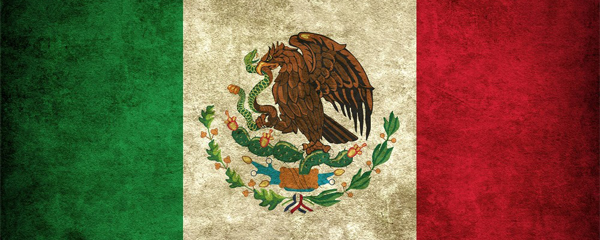06
May 2015
The Business guide for Mexico
1. Mexico In A Nutshell
- Capital City: Mexico City
- Population: 120,286,655 (estimate 2014 The World Factbook)
- Language: Spanish, however many people in the international business community are bilingual in both Spanish and English.
- GDP 2013: USD $1.845 Trillion
- Unemployment Rate 2013: 5.08%
- Inflation: 4.3%
- Currency: Mexican Peso
- Time Zone: Most of Mexico is CST/GMT-6 (Central Standard Time), however far western states use MST/GMT-7 (Mountain Standard Time) and PST/GMT-8 (Pacific Standard Time)
- Telephone Code: +52
- Internet Domain: .mx
- Electricity Voltage: 120V / 60 Hz
- President: Enrique Peña Nieto
2. Mexico’s Economy
 2.1 – GDP Figures (2013)
2.1 – GDP Figures (2013)
GDP: USD $1.845 TrillionGDP growth rate: 1.2%GDP per capita: $15,600GDP Composition by sector: Agriculture (3.6%), Industry (36.6%), Services (59.8%)
2.2 Economic Outlook
Mexico’s economy has one of the most positive forecasts in all of Latin America due to a number of recent reforms implemented by the current government administration. Mexico is working to reduce its dependency on the US in an effort to ensure long-term growth and industry diversification. Investor confidence has returned and new laws in the finance, telecommunications, and energy industries are making the country more appealing to public and foreign investment as a result which is also expected to have a positive influence on Mexico’s economy in the coming years.
A number of significant projects throughout the country, including billions of dollars worth of investments into the country’s infrastructure, are also expected to contribute to continued growth. Another advantage Mexico has is the number of Free Trade Agreements (FTAs) to which they belong. These agreements are continually being adapted and Mexico is always working to grow their trade network in an effort grow their economy for years. And, low manufacturing costs, on par with costs in China, coupled with technological advances continue to foster growth in exports.
2.3 Trade and Economic Challenges
While the long-term economic forecast is looking positive for Mexico, the country is not without trade and economic challenges to ensure such a future as growth in 2013 and 2014 is expected to fall significantly short of original growth projections. While Mexico is continually expanding their trade network through trade agreements, many trade partners are not taking advantage of the agreement incentives for a number of reasons such as shipping costs and infrastructure challenges.
High crime rates also contribute to growth challenges startups and business expansion due to the high costs associated with preventing crime from extortion and corruption to theft of goods during transport and paying for private security. These additional costs, which are not present to such an extensive degree in many other Latin American countries, are hindering growth opportunities on a large scale.
3. Trading With Mexico
3.1 Trading Partners
To this day, largely due to the North America Free Trade Agreement (NAFTA), the US continues to be Mexico’s largest export trading partner and is likely to continue to be so for several years to come; however, the majority percentage continues to decline on a yearly basis as Mexico works to minimize their dependency on the US economy. Large import partners are the US, China, and Japan in addition to smaller percentages from a number of FTA partners.
Largest Export Partners (2012)
- – USA (78%)
- – Canada (3%)
- – Spain (2.1%)
- – China (2.0%)
- – Colombia (1.8%)
Largest Import Partners (2012)
- – USA (49.9%)
- – China (15.4%)
- – Japan (4.8%)
- – Germany (4.2%)
- – Korea (3.9%)
3.2 Import Export Commodities
Largest Export Commodities (2012)
- – Electrical Machinery ($74.7 billion)
- – Motor Vehicles & Parts ($70.3 billion)
- – Industrial Machinery ($53.7 billion)
- – Oil & Mineral Fuels ($50.1 billion)
- – Precious Stones & Metals ($13.2 billion)
Largest Import Commodities (2012)
- – Electrical Machinery ($77.4 billion)
- – Industrial Machinery ($60.8 billion)
- – Oil & Mineral Fuels ($33.3 billion)
- – Motor Vehicles & Parts ($32.4 billion)
- – Plastics ($19.8 billion)
3.3 Trading Infrastructure
 Major Airports and Ports
Major Airports and Ports
Mexico is a large country with diverse terrain and each region is unique in industry and culture much like most highly populated or geographically vast countries. Business hubs are traditionally in the Northern section of the country, or rather Mexico City and North; whereas, the Southern section of the country is primarily more rural with a large tourist population in specific areas. Airports are an essential part of travel in Mexico; likewise, ports are also critical to safely and efficiently move goods throughout the country. Travel and transport between major cities via road, rail, sea, and air is relatively easy; however, travel and transport to more remote areas may be somewhat challenging at times.
Airports – 5 busiest
- – Mexico City International Airport
- – Cancun International Airport
- – Guadalajara International Airport
- – General Mariano Escobedo International Airport (Monterrey)
- – Tijuana International Airport
Ports
 Mexico has dozens of ports scattered throughout the country on all waterways in the interior on riverways and on the exteriors of both the Atlantic and Pacific Ocean coasts. Ports are both publically and privately operated, depending upon the port in question, and each is unique in its capacity, efficiency, and service offerings.
Mexico has dozens of ports scattered throughout the country on all waterways in the interior on riverways and on the exteriors of both the Atlantic and Pacific Ocean coasts. Ports are both publically and privately operated, depending upon the port in question, and each is unique in its capacity, efficiency, and service offerings.
Selecting the correct port for your needs will depend upon many aspects such as the type of container you are shipping, the commodity, your final destination, and much more. Each port has its own set of limitations and advantages. Some are owned and operated privately; whereas, other ports are owned and operated by state governments. Very few ports in Latin America are able to receive the large Panamax ocean vessels. The primary ports of Mexico include, Coatzacoalcos, Ensenada, Manzanillo, Progreso, Salinas Cruz, Tampico and Topolobampo.
3.4 Time and Cost to Import into Mexico
The time and cost to import into Mexico varies. If the exporting country is part of a free trade agreement with Mexico and the imported good is subject to the benefits of the agreement, it is likely minimal to no import tariffs or customs fees will applied. If the exporting country is not a member of any bilateral agreement or trade bloc with Mexico, goods will be subject to import duties, sales tax, and a customs processing fee. If the goods are shipped into a free trade zone, they can be accepted, repackaged, and exported without having to pay import fees. Do not forget to consider Incoterms before you sign any sales contracts as this will affect your duties. The transit time to Mexico varies from a few days or less for ocean vessels originating from most US ports and up to a month for non-direct shipments originating in Asia.
3.5 Tax Free Zones
- – The Logistik Free Trade Zone in San Potosi
- – Strategic intermodal terminal in Pical Pantaco
- – Puerto Fronterizo de Colombia Free Trade Zone
- – Puerto Interior Guanajuato Free Trade Zone
3.6 – Mexico’s Free Trade Agreements (FTAs)
 At this time, roughly 50% of imports are from the US and 80% of their exports go to the US due to the enormous success of NAFTA. As a result of such success, Mexico is rapidly expanding their FTAs as a way to ensure long-term growth and continued prosperity well into the 21st Century. Here are the most significant Free Trade Agreements:
At this time, roughly 50% of imports are from the US and 80% of their exports go to the US due to the enormous success of NAFTA. As a result of such success, Mexico is rapidly expanding their FTAs as a way to ensure long-term growth and continued prosperity well into the 21st Century. Here are the most significant Free Trade Agreements:
APEC – Asia-Pacific Economic Cooperation
A unique aspect pertaining to APEC is that it is manage by the participating governments and does not require contractual obligation which is quite different than most trade agreements. At this time, 21 countries make up this agreement which is designed to reduce barriers in trade amongst the member countries which includes Chile, Mexico, and Peru.
EU – Mexico Economic Partnership, Political Cooperation and Cooperation Agreement
Countries include the EU nations and Mexico. The focus of this agreement is to create free trade in goods and services, as well as to improve political relationships between the participating parties. In addition to the more traditional agreement parameters, part of the critical focus that is unique to this agreement is that of securing human rights for the nations’ people for all involved, climate change, job creation, foreign investment development, intellectual property rights protection, and more.
Mexico – Central America
Countries include Mexico, Guatemala, Honduras, Costa Rica, El Salvador, and Nicaragua. This FTA is a success story of great proportion. After years of slowly removing trade barriers through a number of various FTAs, at this time, nearly all duties have been eliminated on all goods entering each other’s countries. In addition to the elimination of tariffs, both countries focus on provisions such as protecting investment, unfair trade practices, market access, rules of origin, and dispute resolution. Any previous agreement with countries who had existing FTAs with Mexico have been replaced by this agreement.
Mexico – European Free Trade Association (EFTA)
Countries include the EFTA nations and Mexico. The agreement reduces or eliminates tariffs on various imports depending upon the industry, encourages greater freedoms in services, and easier public procurement and foreign investment.
NAFTA – North American Free Trade Agreemeny
Countries include Mexico, the US, and Canada. NAFTA was one of the most prolific and pioneering Free Trade Agreements to date. It is a highly complex trade bloc with a number of benefits to all countries involved such as:
- Tariff reductions and the elimination of tariffs on nearly all goods.
- The protection of foreign investors to be treated with the same benefits as members who are not originally from a member country.
- Protection of intellectual property.
- Easier travel for businesspersons.
- Environment protection cooperation
For those trading within this bloc, you should take the time to determine the ways in which your company will benefit from this highly advantageous partnership.
4. Mexico’s Business Opportunities
4.1 Investment Grade
Due to the current administration’s intense efforts to pass a number of economic reforms, world renown credit rating agency Moody upgraded Mexico’s investment grade to an A. Mexico and Chile are the only two countries in Latin America to have this superior investment grade rating at this time. Both additional global credit rating agencies, Standard and Poor’s and Fitch, are also both expected to raise their ratings for Mexico, as well. The Mexican administration is working diligently to reduce its dependence upon the US through such passing economic reforms, establishing more trade agreements, and creating a more appealing investment environment overall.
One of the most influential achievements in investment has been the passing of the public-private partnership (PPP) law in 2012. Essentially, the law was created to provide clarity and transparency pertaining to the rights and responsibilities of all parties involved in each investment that is protected by the law. The results have been less risk for investors, greater access to financing, and lower project costs, all of which are attracting even more investors at all levels. The law also allows for private companies to submit unsolicited proposals for infrastructure projects which is resulting in higher quality and more affordable options and a significant increase in foreign investment interests.
According to the Bloomberg Best for Business in Latin America 2014 report, Mexico is ranked at number five in the region. The rankings were based on a number of factors such as the degree of economic integration, the cost of establishing a new business, cost of labor and material, cost of moving goods, and more.
4.2 Growing investment opportunities: Energy, Infrastructure, and Telecommunications
The reforms are providing new s ecure investment opportunities in a number of Mexican industries. Mexico is focusing on road infrastructure on a national level which has attracted a number of foreign investors from the UK, Spain, Canada, and more. The most recent reforms are allowing for competition in both the oil and gas industries, modifications to the banking system, broadening the banking system, dismantling big telecommunication businesses, placing restrictions on the teachers’ union, and allowing Congress member to be re-elected. Each of these recent reforms are expected to continue to move the country in a positive direction and create nearly limitless investment opportunities in numerous sectors.
ecure investment opportunities in a number of Mexican industries. Mexico is focusing on road infrastructure on a national level which has attracted a number of foreign investors from the UK, Spain, Canada, and more. The most recent reforms are allowing for competition in both the oil and gas industries, modifications to the banking system, broadening the banking system, dismantling big telecommunication businesses, placing restrictions on the teachers’ union, and allowing Congress member to be re-elected. Each of these recent reforms are expected to continue to move the country in a positive direction and create nearly limitless investment opportunities in numerous sectors.
4.3 E-Commerce and Startups
The recent shift in cultural attitudes toward technology is also contributing positively to e-commerce and startup industries. As of 2013, Mexico had the second largest e-commerce market in Latin America representing 18% of the overall Latin American market share and it is expected to grow at a compound rate of 25% until 2016. It is also forecasted that business-to-consumer e-commerce sales will reach $10 billion by the end of 2014. As the connectivity rate grows due to the telecommunication reforms and projects, this number is expected to reach unprecedented figures by 2018.
The startup scene is also growing rapidly. At this time, the Mexican startup industry faces a number of challenging obstacles to overcome; however, many startups and entrepreneurs have discovered that creating partnerships with US companies has been an advantageous and strategic methodology to overcome such obstacles. While it is possible to find incubator programs and a limited number of investors, a desperate need for investment capital and educational programs exists in order for the startup community to reach the levels of many other Latin American countries. With that being said, the government has created the National Entrepreneurial Institute in an effort to begin bridging the gap and to encourage the leaders of tomorrow to continue moving Mexico in the right direction for decades to come.
How about you: Do you have something else to add?
Read the Complete Guide of Mexico HERE
See more at sbeinspection.com































